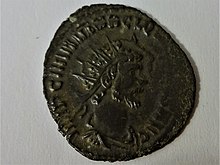False coinage (numismatics)
In the numismatics referred Fehlprägung one by the embossing process unintentionally created , faulty coin . Be distinguished from the Fehlprägung in the strict sense are other causes based error coins, such as the Zainende or other Schrötlingsfehler that existed even before the actual embossing or have been passing through the minting errors much favored. A distinction must therefore be made between: planar defects, stamp defects and embossing defects.
Flint defects
A Schrötlingsfehler formed for example by a Zainende so that, in the embossing of the Schrötling later too small or is not designed so that by a defective surface, during the subsequent embossing the entire surface by embossing.
Stamp error
Even before the embossing process, a stamping error can cause an incorrect embossing . Until well into the 19th century, die cutters underwent reversed letters or mirror-inverted engraving of letters and numbers. An example of this are incorrect minting of 1/24 thaler coins (groschen) from the Grand Duchy of Saxony-Weimar-Eisenach in which the ones of the year 1810 appear mirror-inverted. A well-known stamping error is a 50-pfennig piece from 1950, which at the time was accidentally struck in Karlsruhe with the inscription " Bank deutscher Länder " and which came into circulation in small numbers. This is a faulty coinage, as a wrong stamp was used for the value side. Correctly, stamps with the inscription "Federal Republic of Germany" were used for more than 300 million 50-pfennig pieces with the year 1950. Around 30,000 coins were minted in the Karlsruhe mint in 1950 (mint mark "G") with the now incorrect inscription "Bank deutscher Länder".
Embossing errors
A minting error in the coin that occurs directly as a result of the minting process is the planar crack. Faults can also occur retrospectively in a previously flawless coin, such as the edge breakage, in particular in the case of coins not produced by ring embossing . These subsequent errors are also to be distinguished from the incorrect coinage. The subsequent edge chipping or even the breaking of the coins is, however, favored by a certain form of incorrect minting: A planar crack occurs if the embossing pressure is too high in relation to the thickness and material of the planar. Ancient coins often show planar cracks. They are so common that, unlike modern minting errors, they are not viewed as increasing in value, but rather as decreasing in value, and the stronger the more they impair the overall appearance of the coin.

There were often minor errors in the early artisanal coinage. The so-called double impact, which was accidentally made, meant that the embossing could be done twice with different strengths and slightly offset. Often the upper punch was not placed correctly before the impact, which led to off-center embossing. These coins are undesigned on the list side in one area and on the opposite area, where the upper punch protruded over the flint, parts of the stamp design could not be transferred to the flint.

Modern misprints
Some modern misprints that had accidentally passed the quality control and got into circulation became coveted collector's items. Misprints can arise in many ways. B. a coin get stuck in the minting ring and is then twisted or minted a second time. It also happens that coins are minted on false blanks , e.g. B. a 1 euro coin on the blank of a 50 cent coin. Dirty dies can also cause errors in the embossed image. If there is a break in the die in the die, this is clearly visible on the coin as a raised line (see Cromwelltaler ). Secondary misprints can occur when coins are overprinted and counterstamps are applied . Overprints often show uneven contours because the original coin is not flat due to its previous coinage. Due to the concentration of forces on only a small area of the coin, counter dies often lead to planar tears.
"Stamp rotations" are relatively common. These are coins whose back is not correctly aligned with the front, for example a 50 cent piece with the Brandenburg Gate “lying” on its side or upside down when the coin is rotated around the vertical axis . This is to be distinguished from the opposite embossing, in which the reverse side is intentionally upside down when turned vertically, as was previously the case in many countries (e.g. France ). In general, die rotations occurred earlier than with new coins due to the lower technical level in the minting process. Usually the image is only rotated by a few degrees, so that the stamp rotation is not noticeable at first glance. The stronger the rotation, the higher the collector's prices that such misprints achieve. Belgian euro coins are a special case , where the number of die rotations is so frequent that the prices for these incorrect mintings are usually barely above the corresponding nominal value.
See also
literature
- Jürg Richter: Misprints and forgeries of Swiss coins from 1850. Helvetische Münzeitung HMZ, Zurich.





